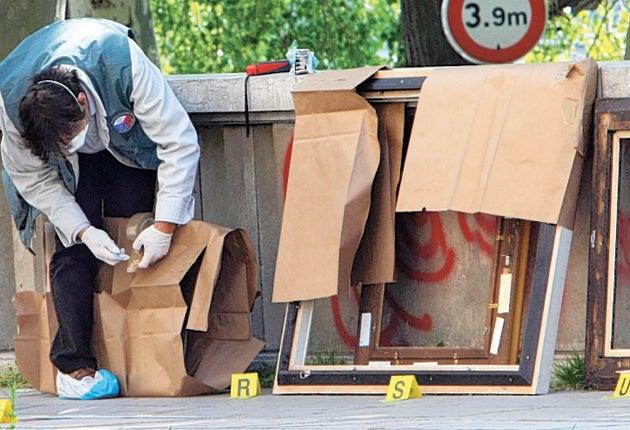Raiders likely to realise just 10 per cent of works' value

Breaking into the Paris Museum of Modern Art under cover of darkness, evading the alarm system and escaping with €100m (£86m) of world famous art is no mean feat. But for whoever who carried out the raid, the hard work is far from over.
Unlike inexpensive stolen watches or cheap jewellery, one-of-a-kind artwork cannot be flogged to a passing punter from a market stall. And they are unlikely to turn up for sale at an auction house or art dealership because by yesterday morning the whole world knew of the theft.
Instead, the thief may have had a buyer lined up and and stole the pieces to order. If so, he or she can expect to receive about 10 per cent of the market value for them, about €10m. Such a price will no doubt have been agreed beforehand, but while the thief has the paintings, the buyer has all the control.
As Roy Ramm, a former Metropolitan Police commander who once ran the force's arts and antiques unit, explained yesterday: "There is no honour among thieves. What if the buyer decides that instead of paying €10m, he now only wants to pay €2m? There isn't much the thief can do. He either takes the money or he is left with some of the world's most valuable paintings, which of course aren't valuable at all if he can't sell them.
"It is also unlikely that the buyer and the thief have ever met. The deal will involve lots of middle men, so if the buyer doesn't get his way he could implicate the thief at a moment's notice and he could do it without implicating himself. Basically, if the thief doesn't get rid of these paintings very quickly he is left with an albatross of enormous proportions around his neck."
If the Paris thief does try to move the paintings through the legitimate art market, he or she will encounter serious difficulties. Quite aside from explaining how they came to acquire a genuine work by one of the world's most famous artists – claiming to have found it in the loft is unlikely to satisfy curiosity – there is also the scrutiny of the Art Loss Register.
Created in 1993, it is a global list of every artwork registered stolen or missing. It has 300,000 items on its database and each time a new art work comes up for sale on the open market, buyers or auction houses can check to see if the piece is on the register to ensure they avoid dealing in stolen goods.
About 400,000 such checks are made each year and about one in 15,000 items for sale turns out to be stolen. So who would buy such pieces, knowing that stolen art is subject to such scrutiny?
"There are James Bond fantasies that some industrialist or art collector is sitting there with a hole on his wall that he wants filled and he has hired a thief to get his prize," Mr Ramm said.
"But it is more likely that these paintings will be bought by someone who runs a criminal enterprise and, through drugs or whatever way he makes his cash, has more money than he knows what to do with."
The fate of stolen art
April 1991 In what was then billed as the world's biggest art robbery, 20 paintings, estimated to be worth £340m, were stolen from the Van Gogh Museum in Amsterdam. They were found shortly afterwards in an abandoned car.
August 2003 Madonna With The Yarnwinder by Leonardo da Vinci was stolen from Drumlanrig Castle in Dumfries by two thieves posing as tourists. The work was valued at about £36m. It was recovered from a Glasgow office in 2007.
August 2004 Armed robbers stole The Scream from the Munch Museum in Oslo. It was the second time in 10 years that a version of the painting was stolen. Thieves also took Madonna by Munch. The paintings, from 1893, were found in August 2006.
February 2008 Four oil paintings by Cézanne, Degas, Van Gogh and Monet were stolen from the Bührle Collection in Zürich. The paintings by Claude Monet and Van Gogh, valued at £43m, were found in good condition a week later in a car in Zürich. The Cézanne and Degas works, worth £112m, are still missing.
Subscribe to Independent Premium to bookmark this article
Want to bookmark your favourite articles and stories to read or reference later? Start your Independent Premium subscription today.

Join our commenting forum
Join thought-provoking conversations, follow other Independent readers and see their replies